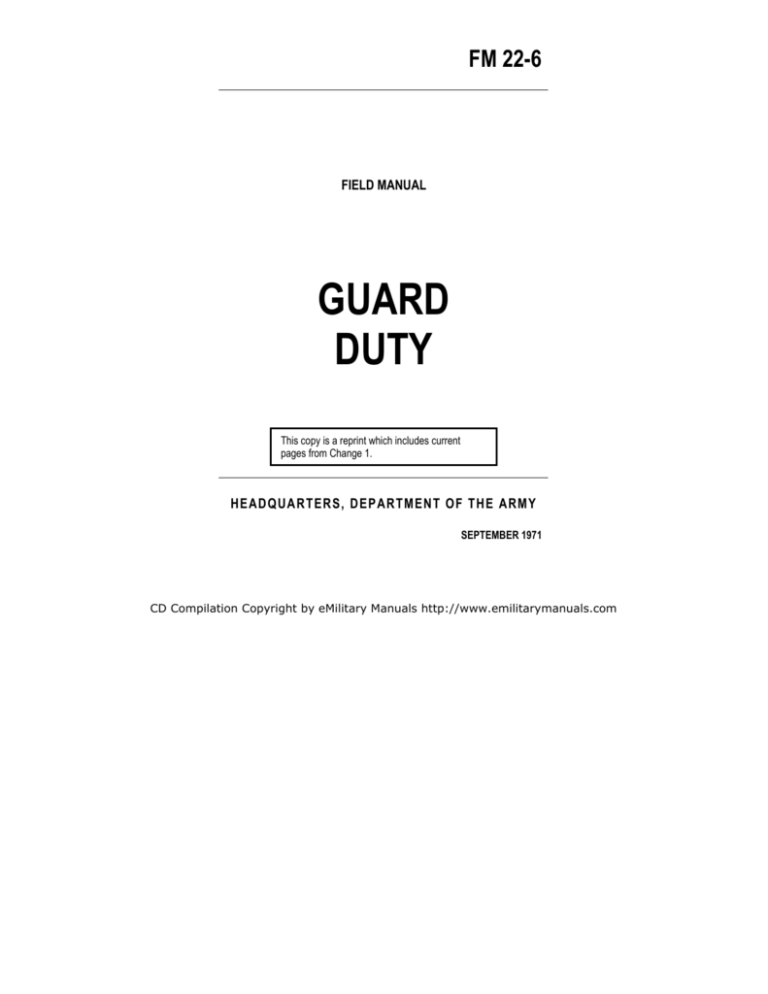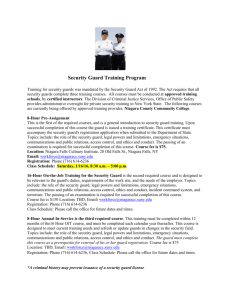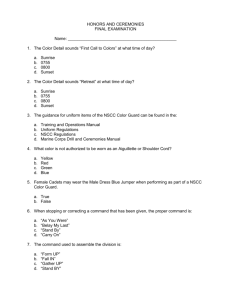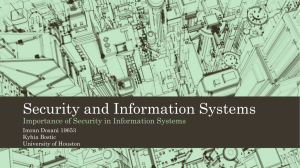guard duty - eMilitary Manuals
advertisement

FM 22-6 FIELD MANUAL GUARD DUTY This copy is a reprint which includes current pages from Change 1. HEADQUARTERS, DEPARTMENT OF THE ARMY SEPTEMBER 1971 CD Compilation Copyright by eMilitary Manuals http://www.emilitarymanuals.com Compilation Copyright by eMilitary Manuals http://www.emilitarymanuals.c Compilation Copyright by eMilitary Manuals http://www.emilitarymanuals.c CD Compilation Copyright by eMilitary Manuals http://www.emilitarymanuals.com DISTRIBUTION RESTRICTION: Approved for public release; distribution is unlimited. Compilation Copyright by eMilitary Manuals http://www.emilitarymanuals.c Compilation Copyright by eMilitary Manuals http://www.emilitarymanuals.c PART ONE INTRODUCTION CHAPTER 1 GENERAL 1. Purpose and Scope a. This manual is for personnel concerned with the organization and functions of interior and exterior guard. It includes orders, countersigns, parole words, and responsibility of the main guard including duties of personnel and methods of mounting the guard. The manual also discusses the duties and composition of special guards. b. As this manual is a guide, and as all possible situations and eventualities cannot be foreseen or covered by the manual, great reliance must be placed upon the application of sound judgment and common sense by all members of a guard and by all security personnel. In situations not covered by this manual and where doubt arises as to the proper action to be taken, the individual must consider his mission and apply sound judgment in making the required decision(s). c. The material in this manual is applicable to both nonnuclear and nuclear warfare. 1-1 Compilation Copyright by eMilitary Manuals http://www.emilitarymanuals.c 2. Comments Users of this publication are encouraged to submit recommended changes or comments to improve the publication. Comments should be keyed to the specific page, paragraph, and line of text in which the change is recommended. Reasons will be provided for each comment to insure understanding and complete evaluation. Comments should be prepared using DA Form 2028 (Recommended Changes to Publications) and forwarded direct to the Commandant, US Army Infantry School, Fort Benning, GA 31905. 1-2 Compilation Copyright by eMilitary Manuals http://www.emilitarymanuals.c CHAPTER 2 TERMINOLOGY 3. General The terminology relative to guard duty is listed below. This list points out words and phrases which have a particular meaning in this manual. 4. Terms a. Commanding Officer. The officer commanding an installation, organization, unit, garrison, or bivouac. b. Field Officer of the Day. A field grade officer detailed as the personal representative of the commanding officer. During his tour of duty he is responsible to the commanding officer for the security of the installation or activity and other duties as may be assigned depending upon local directives. c. Officer of the Day. An officer, acting directly under the commanding officer or field officer of the day, who is responsible on a given day for the execution of all orders of the commanding officer relating to guard duty and other duties as may be assigned. d. Commander of the Guard. The senior officer or noncommissioned officer of the guard, next junior to the officer of the day. He is responsible for the instruction, discipline, and performance of duty of the guard. 2-1 Compilation Copyright by eMilitary Manuals http://www.emilitarymanuals.c e. Sergeant of the Guard. The senior noncom missioned officer of the guard. He supervises the enlisted members of the guard and is responsible to the commander of the guard. f. Relief Commander(s). The next senior noncommissioned officer(s) of the guard. g. Main Guard. Regular interior guard of a post or unit whose principal duties are to patrol the area and protect the personnel, buildings, and equipment. A main guard is a subdivision of the interior guard of a command. Other subdivisions include escort guard or honor guards, for example. h. Fixed Post System. Assigning sentinels to guard duty at fixed posts where they remain until relieved. i. Guard. A term used when referring to— (1) A special unit responsible to the officer of the day for the protection and security of an installation or area. This unit includes a commander of the guard, sergeant of the guard, commanders of the relief, and the guards. (2) An individual responsible to keep watch over, protect, shield, defend, warn, or any duties prescribed by general orders and/or special orders. Also referred to as a sentinel, sentry, or lookout. (a) Sentinel. An individual of the guard whose duties are prescribed by general and/or special orders. Also referred to as a guard, sentry, or lookout. (b) Sentry. A guard, sentinel, or lookout. j. Guard’s Post. An area for which the guard is responsible. Within his post, a guard performs the duties required by general and special orders. 2-2 Compilation Copyright by eMilitary Manuals http://www.emilitarymanuals.c k. Supernumerary. An extra member of the guard who is used when needed to replace a guard or perform duties prescribed by local directives. l. Guardhouse. A building, tent, or other location occupied by men detailed for interior guard duty. It is the headquarters for the guard. m. Correctional Officer. The correctional officer, appointed by the commanding officer of a military installation, is charged with the custody, administration, and treatment of prisoners. n. Stockade. A correctional facility, under the jurisdiction of an installation commander, used for the confinement of military prisoners. o. Challenge (app F). Any process carried out by one unit or person with the object of ascertaining the friendly or hostile character or identity of another. The command “HALT, WHO IS THERE?” is used to cause an unidentified party or person to halt and be identified. If an additional challenge is used, it follows the original challenge and consists of a word or distinctive sound disseminated only to friendly or authorized persons. p. Countersign (app F). A countersign consists of two words: the secret challenge and its password. The words comprising the countersign are issued from the principal headquarters of a command to aid guards in their scrutiny of persons who apply to pass (chap 9). These words are disseminated only to friendly personnel. (1) Challenge. The first word or part of the countersign, used to challenge a person or party. It is disseminated only to friendly personnel. (2) Password. A secret word or distinctive 2-3 Compilation Copyright by eMilitary Manuals http://www.emilitarymanuals.c sound used to reply to a challenge. The second word or part of the countersign. It is used in answer the challenge and is disseminated only to friendly personnel. (3) Parole. A special password used as a check on the countersign. For a more complete explanation, refer to chapter 9. 2-4 Compilation Copyright by eMilitary Manuals http://www.emilitarymanuals.c CHAPTER 3 GUARD COMPOSITION 5. General The guard may be one of two types, interior guard (part two) or exterior guard (part three). 6. Interior Guard An interior guard is detailed by commanders of military installations to protect property and enforce specific military regulations. The installation commander is responsible for the interior guard of the installation and he prescribes the composition of the guard. When brigades and separate units are responsible for an interior guard within their own areas, their composition, duties, and responsibilities are similar to those outlined in this manual. Commanders of units furnishing personnel for guard are responsible to insure that these men are qualified or familiar with the weapon they use on guard. The elements of an interior guard are classified according to their purpose. They include the main guard and special guards. The main guard consists of a combination of patrols and fixed posts. Special guards are used, to protect parks, trains, boats, aircraft, and for other special purposes (fig 1). 3-1 Compilation Copyright by eMilitary Manuals http://www.emilitarymanuals.c 7. Exterior Guard This is a term used in this manual to differentiate from interior guard. Exterior guards are those guards whose duties and responsibilities are different from those set down for interior guards. Exterior guard is not as formal and restricted as interior guard. Classified as exterior guards are lookouts, listening posts, outposts, specifically designated patrols, and other guards in combat zones, field training areas, and guards outside the limits of a military installation. Exterior guards perform their duties as prescribed by special orders and instructions. 3-2 Compilation Copyright by eMilitary Manuals http://www.emilitarymanuals.c PART TWO INTERIOR GUARD CHAPTER 4 ORDERS 8. Classes of Orders A guard on post is governed by two types of orders: general orders and special orders. General orders outline the fundamental responsibilities of a guard while special orders instruct him in the actual performance of his duty while on a particular post. General orders for both interior and exterior guards must be supplemented by realistic, detailed, and mission-oriented special orders carefully tailored for the specific post and situation from the viewpoint of security and sentry effectiveness and protection. The special orders for each post must be reviewed frequently to insure they do not become obsolete. A special order may be added to a guard post for a specific length of time to cover a certain situation and deleted at the end of a specified time, or on a certain data. 9. General Orders All interior guards are required to memorize, understand, and comply with the following general orders: a. Number 1. I will guard everything within the 4-1 Compilation Copyright by eMilitary Manuals http://www.emilitarymanuals.c





